Thermal Exfoliation and Phosphorus Doping in Graphitic Carbon Nitride for Efficient Photocatalytic Hydrogen Production
Abstract
1. Introduction
2. Results
3. Materials and Methods
3.1. Materials
3.2. Preparation of g-C3N4
3.3. Preparation of PCN
3.4. Preparation of PCNS
3.5. Characterizations
3.6. Evaluation of Photocatalytic Activity
4. Conclusions
Supplementary Materials
Author Contributions
Funding
Institutional Review Board Statement
Informed Consent Statement
Data Availability Statement
Conflicts of Interest
References
- Wang, M.; Cheng, J.; Wang, X.; Hong, X.; Fan, J.; Yu, H. Sulfur-mediated photodeposition synthesis of NiS cocatalyst for boosting H2-evolution performance of g-C3N4 photocatalyst. Chin. J. Catal. 2021, 42, 37–45. [Google Scholar] [CrossRef]
- Wang, R.; Cao, X.; Huang, H.; Ji, X.; Chen, X.; Liu, J.; Yan, P.; Wei, S.; Chen, L.; Wang, Y. Facile Chemical Vapor Modification Strategy to Construct Surface Cyano-Rich Polymer Carbon Nitrides for Highly Efficient Photocatalytic H2 Evolution. ChemSusChem 2022, 15, 202201575. [Google Scholar] [CrossRef]
- Wang, S.; Wang, X.; Liu, B.; Xiao, X.; Wang, L.; Huang, W. Boosting the photocatalytic hydrogen production performance of graphitic carbon nitride nanosheets by tailoring the cyano groups. J. Colloid Interface Sci. 2022, 610, 495–503. [Google Scholar] [CrossRef]
- Wang, X.; Jin, Z. Adjusting inter-semiconductor barrier height via crystal plane engineering: Crystalline face exposed single crystal cadmium sulfide augmentative S-scheme heterojunctions for efficiently photocatalytic hydrogen production. Appl. Catal. B Environ. 2024, 342, 123373–123388. [Google Scholar] [CrossRef]
- Zhai, H.; Tan, P.; Lu, L.; Liu, H.; Liu, Y.; Pan, J. Abundant hydroxyl groups decorated on nitrogen vacancy-embedded g-C3N4 with efficient photocatalytic hydrogen evolution performance. Catal. Sci. Technol. 2021, 11, 3914–3924. [Google Scholar] [CrossRef]
- Zhang, Q.; Sun, Y.; Deng, J.; Liu, Y.; Ng, Y.H.; Jing, L.; Dai, H. Defect-rich selenium doped graphitic carbon nitride for high-efficiency hydrogen evolution photocatalysis. Int. J. Hydrogen Energy 2023, 48, 31590–31598. [Google Scholar] [CrossRef]
- Sun, X.-J.; Yang, D.-D.; Dong, H.; Meng, X.-B.; Sheng, J.-L.; Zhang, X.; Wei, J.-Z.; Zhang, F.-M. ZIF-derived CoP as a cocatalyst for enhanced photocatalytic H2 production activity of g-C3N4. Sustain. Energy Fuels 2018, 2, 1356–1361. [Google Scholar] [CrossRef]
- Chen, Z.; Xia, K.; She, X.; Mo, Z.; Zhao, S.; Yi, J.; Xu, Y.; Chen, H.; Xu, H.; Li, H. 1D metallic MoO2-C as co-catalyst on 2D g-C3N4 semiconductor to promote photocatlaytic hydrogen production. Appl. Surf. Sci. 2018, 447, 732–739. [Google Scholar] [CrossRef]
- Huang, Z.; Chen, H.; He, X.; Fang, W.; Li, W.; Du, X.; Zeng, X.; Zhao, L. Constructing a WC/NCN Schottky Junction for Rapid Electron Transfer and Enrichment for Highly Efficient Photocatalytic Hydrogen Evolution. ACS Appl. Mater. Interfaces 2021, 13, 46598–46607. [Google Scholar] [CrossRef]
- Deng, Y.; Zhou, Z.; Zeng, H.; Tang, R.; Li, L.; Wang, J.; Feng, C.; Gong, D.; Tang, L.; Huang, Y. Phosphorus and kalium co-doped g-C3N4 with multiple-locus synergies to degrade atrazine: Insights into the depth analysis of the generation and role of singlet oxygen. Appl. Catal. B Environ. 2023, 320, 121942. [Google Scholar] [CrossRef]
- Fei, T.; Qin, C.; Zhang, Y.; Dong, G.; Wang, Y.; Zhou, Y.; Cui, M. A 3D peony-like sulfur-doped carbon nitride synthesized by self-assembly for efficient photocatalytic hydrogen production. Int. J. Hydrogen Energy 2021, 46, 20481–20491. [Google Scholar] [CrossRef]
- Gong, Q.; Cao, S.; Zhou, Y.; Wang, R.; Jiao, W. Mesoporous g-C3N4 decorated by Ni2P nanoparticles and CdS nanorods together for enhancing photocatalytic hydrogen evolution. Int. J. Hydrogen Energy 2021, 46, 21442–21453. [Google Scholar] [CrossRef]
- Kröger, J.; Jiménez-Solano, A.; Savasci, G.; Lau, V.W.H.; Duppel, V.; Moudrakovski, I.; Küster, K.; Scholz, T.; Gouder, A.; Schreiber, M.L.; et al. Lotsch, Morphology Control in 2D Carbon Nitrides: Impact of Particle Size on Optoelectronic Properties and Photocatalysis. Adv. Funct. Mater. 2021, 31, 2102468. [Google Scholar] [CrossRef]
- Huo, Y.; Zhang, J.; Wang, Z.; Dai, K.; Pan, C.; Liang, C. Efficient interfacial charge transfer of 2D/2D porous carbon nitride/bismuth oxychloride step-scheme heterojunction for boosted solar-driven CO2 reduction. J. Colloid Interface Sci. 2021, 585, 684–693. [Google Scholar] [CrossRef] [PubMed]
- Lei, J.; Gu, X.; Xiao, P.; Ding, G.; Yang, Y.; Fu, X.; Long, B.; Chen, S.; Meng, S. Fabrication of 2D/2D BiOBr/g-C3N4 with efficient photocatalytic activity and clarification of its mechanism. Phys. Chem. Chem. Phys. 2022, 24, 19806–19816. [Google Scholar] [CrossRef]
- Guo, L.; Xu, F.; Liu, Z.; Zhang, M.; Ma, D.; Lai, C.; Liu, S.; Li, L.; Fu, Y.; Qin, L. Constructing benzene ring modified graphitic carbon nitride with narrowed bandgap and enhanced molecular oxygen activation for efficient photocatalytic degradation of oxytetracycline. Sep. Purif. Technol. 2022, 294, 121170. [Google Scholar] [CrossRef]
- Dang, T.T.; Nguyen, T.K.A.; Bhamu, K.C.; Mahvelati-Shamsabadi, T.; Van, V.K.H.; Shin, E.W.; Chung, K.-H.; Hur, S.H.; Choi, W.M.; Kang, S.G.; et al. Engineering Holey Defects on 2D Graphitic Carbon Nitride Nanosheets by Solvolysis in Organic Solvents. ACS Catal. 2022, 12, 13763–13780. [Google Scholar] [CrossRef]
- Gao, S.; Wang, X.; Song, C.; Zhou, S.; Yang, F.; Kong, Y. Engineering carbon-defects on ultrathin g-C3N4 allows one-pot output and dramatically boosts photoredox catalytic activity. Appl. Catal. B Environ. 2021, 295, 120272. [Google Scholar] [CrossRef]
- Lei, L.; Wang, W.; Shang, Y.; Li, J.; Yadav, A.K.; Wang, H.; Li, Q.; Fan, H. Tailoring chemical structures and intermolecular interactions of melem intermediates for highly efficient photocatalytic hydrogen evolution of g-C3N4. Appl. Surf. Sci. 2021, 563, 150384. [Google Scholar] [CrossRef]
- Shen, H.; Li, M.; Guo, W.; Li, G.; Xu, C. P, K co-doped porous g-C3N4 with enhanced photocatalytic activity synthesized in vapor and self-producing NH3 atmosphere. Appl. Surf. Sci. 2020, 507, 145086. [Google Scholar] [CrossRef]
- Chen, L.; Yan, G.; Liu, X.; Ying, S.; Xia, Y.; Ning, S.; Wang, X. Phosphorus doped and defect modified graphitic carbon nitride for boosting photocatalytic hydrogen production. Phys. Chem. Chem. Phys. 2022, 25, 117–123. [Google Scholar] [CrossRef] [PubMed]
- Ou, H.; Lin, L.; Zheng, Y.; Yang, P.; Fang, Y.; Wang, X. Tri-s-triazine-Based Crystalline Carbon Nitride Nanosheets for an Improved Hydrogen Evolution. Adv. Mater. 2017, 29, 1700008. [Google Scholar] [CrossRef] [PubMed]
- Ren, M.; Zhang, X.; Liu, Y.; Yang, G.; Qin, L.; Meng, J.; Guo, Y.; Yang, Y. Interlayer Palladium-Single-Atom-Coordinated Cyano-Group-Rich Graphitic Carbon Nitride for Enhanced Photocatalytic Hydrogen Production Performance. ACS Catal. 2022, 12, 5077–5093. [Google Scholar] [CrossRef]
- Shen, R.; Xie, J.; Lu, X.; Chen, X.; Li, X. Bifunctional Cu3P Decorated g-C3N4 Nanosheets as a Highly Active and Robust Visible-Light Photocatalyst for H2 Production. ACS Sustain. Chem. Eng. 2018, 6, 4026–4036. [Google Scholar] [CrossRef]
- Shi, W.; Shu, K.; Sun, H.; Ren, H.; Li, M.; Chen, F.; Guo, F. Dual enhancement of capturing photogenerated electrons by loading CoP nanoparticles on N-deficient graphitic carbon nitride for efficient photocatalytic degradation of tetracycline under visible light. Sep. Purif. Technol. 2020, 246, 116930. [Google Scholar] [CrossRef]
- Bai, X.; Wang, X.; Lu, X.; Hou, S.; Sun, B.; Wang, C.; Jia, T.; Yang, S. High crystallinity and conjugation promote the polarization degree in O-doped g-C3N4 for removing organic pollutants. CrystEngComm 2021, 23, 1366–1376. [Google Scholar] [CrossRef]
- Beyhaqi, A.; Azimi, S.M.T.; Chen, Z.; Hu, C.; Zeng, Q. Exfoliated and plicated g-C3N4 nanosheets for efficient photocatalytic organic degradation and hydrogen evolution. Int. J. Hydrogen Energy 2021, 46, 20547–20559. [Google Scholar] [CrossRef]
- Bi, F.; Su, Y.; Zhang, Y.; Chen, M.; Darr, J.A.; Weng, X.; Wu, Z. Vacancy-defect semiconductor quantum dots induced an S-scheme charge transfer pathway in 0D/2D structures under visible-light irradiation. Appl. Catal. B Environ. 2022, 306, 121109. [Google Scholar] [CrossRef]
- Chen, H.; Wang, W.; Yang, Z.; Suo, X.; Lu, Z.; Xiao, W.; Dai, S. Alkaline salt-promoted construction of hydrophilic and nitrogen deficient graphitic carbon nitride with highly improved photocatalytic efficiency. J. Mater. Chem. A 2021, 9, 4700–4706. [Google Scholar] [CrossRef]
- Chen, J.; Zhu, X.; Jiang, Z.; Zhang, W.; Ji, H.; Zhu, X.; Song, Y.; Mo, Z.; Li, H.; Xu, H. Construction of brown mesoporous carbon nitride with a wide spectral response for high performance photocatalytic H2 evolution. Inorg. Chem. Front. 2022, 9, 103–110. [Google Scholar] [CrossRef]
- Chen, Y.; Lei, L.; Gong, Y.; Wang, H.; Fan, H.; Wang, W. Enhanced electron delocalization on pyrimidine doped graphitic carbon nitride for boosting photocatalytic hydrogen evolution. Int. J. Hydrogen Energy 2023, 51, 1058–1106. [Google Scholar] [CrossRef]
- Cheng, J.; Hou, Y.; Lian, K.; Xiao, H.; Lin, S.; Wang, X. Metalized Carbon Nitrides for Efficient Catalytic Functionalization of CO2. ACS Catal. 2022, 12, 1797–1808. [Google Scholar] [CrossRef]
- Song, T.; Zhang, X.; Yang, P. Interface engineering of W2C/W2N co-catalyst on g-C3N4 nanosheets for boosted H2 evolution and 4-nitrophenol removal. Environ. Sci. Nano 2022, 9, 1888–1899. [Google Scholar] [CrossRef]
- Li, P.; Wang, M.; Huang, S.; Su, Y. Phosphorus- and fluorine-co-doped carbon nitride: Modulated visible light absorption, charge carrier kinetics and boosted photocatalytic hydrogen evolution. Dalton Trans. 2021, 50, 14110–14114. [Google Scholar] [CrossRef] [PubMed]
- Ma, J.; Jin, D.; Yang, X.; Sun, S.; Zhou, J.; Sun, R. Phosphorus-doped carbon nitride with grafted sulfonic acid groups for efficient photocatalytic synthesis of xylonic acid. Green Chem. 2021, 23, 4150–4160. [Google Scholar] [CrossRef]
- Sun, K.; Shen, J.; Liu, Q.; Tang, H.; Zhang, M.; Zulfiqar, S.; Lei, C. Synergistic effect of Co(II)-hole and Pt-electron cocatalysts for enhanced photocatalytic hydrogen evolution performance of P-doped g-C3N4. Chin. J. Catal. 2020, 41, 72–81. [Google Scholar] [CrossRef]
- Xu, J.; Qi, Y.; Wang, W.; Wang, L. Montmorillonite-hybridized g-C3N4 composite modified by NiCoP cocatalyst for efficient visible-light-driven photocatalytic hydrogen evolution by dye-sensitization. Int. J. Hydrogen Energy 2019, 44, 4114–4122. [Google Scholar] [CrossRef]
- Liu, F.; Li, W.; Wang, L.; Rao, X.; Zheng, S.; Zhang, Y. Sulfur- and Strontium-Doped Graphitic Carbon Nitride for Efficient Photocatalytic Hydrogen Evolution. ACS Appl. Energy Mater. 2022, 5, 15834–15843. [Google Scholar] [CrossRef]
- Liu, W.; Peng, R.; Ye, X.; Guo, J.; Luo, L. Sulfur doping and structure defect functionalized carbon nitride nanosheets with enhanced photocatalytic degradation activity. Appl. Surf. Sci. 2021, 560, 150013. [Google Scholar] [CrossRef]
- Luo, L.; Wang, K.; Gong, Z.; Zhu, H.; Ma, J.; Xiong, L.; Tang, J. Bridging-nitrogen defects modified graphitic carbon nitride nanosheet for boosted photocatalytic hydrogen production. Int. J. Hydrogen Energy 2021, 46, 25004. [Google Scholar] [CrossRef]
- Wang, D.; Dong, X.; Lei, Y.; Lin, C.; Huang, D.; Yu, X.; Zhang, X. Fabrication of Mn/P co-doped hollow tubular carbon nitride by a one-step hydrothermal–calcination method for the photocatalytic degradation of organic pollutants. Catal. Sci. Technol. 2022, 12, 5709–5722. [Google Scholar] [CrossRef]
- Liu, W.; Zhang, D.; Wang, R.; Zhang, Z.; Qiu, S. 2D/2D Interface Engineering Promotes Charge Separation of Mo2C/g-C3N4 Nanojunction Photocatalysts for Efficient Photocatalytic Hydrogen Evolution. ACS Appl. Mater. Interfaces 2022, 14, 31782–31791. [Google Scholar] [CrossRef] [PubMed]
- Liu, Y.; Zhao, S.; Wang, Y.; Xie, L.; Fang, J.; Zhang, Y.; Zhou, Y.; Zhuo, S. Controllable fabrication of 3D porous carbon nitride with ultra-thin nanosheets templated by ionic liquid for highly efficient water splitting. Int. J. Hydrogen Energy 2021, 46, 25004–25014. [Google Scholar] [CrossRef]
- Long, X.; Feng, C.; Yang, S.; Ding, D.; Feng, J.; Liu, M.; Chen, Y.; Tan, J.; Peng, X.; Shi, J.; et al. Oxygen doped graphitic carbon nitride with regulatable local electron density and band structure for improved photocatalytic degradation of bisphenol A. Chem. Eng. J. 2022, 435, 134835. [Google Scholar] [CrossRef]
- Pan, Z.; Liu, M.; Zhang, G.; Zhuzhang, H.; Wang, X. Molecular Triazine–Heptazine Junctions Promoting Exciton Dissociation for Overall Water Splitting with Visible Light. J. Phys. Chem. C 2021, 125, 9818–9826. [Google Scholar] [CrossRef]
- Zhou, Y.; Lv, W.; Zhu, B.; Tong, F.; Pan, J.; Bai, J.; Zhou, Q.; Qin, H. Template-Free One-Step Synthesis of g-C3N4 Nanosheets with Simultaneous Porous Network and S-Doping for Remarkable Visible-Light-Driven Hydrogen Evolution. ACS. Sustain. Chem. Eng. 2019, 7, 5801–5807. [Google Scholar] [CrossRef]
- Chava, R.K.; Kang, M. Ordered and carbon-doped porous polymeric graphitic carbon nitride nanosheets toward enhanced visible light absorption and efficient photocatalytic H2 evolution. Nanoscale 2023, 15, 18347–18358. [Google Scholar] [CrossRef] [PubMed]
- Guo, S.; Deng, Z.; Li, M.; Jiang, B.; Tian, C.; Pan, Q.; Fu, H. Phosphorus-Doped Carbon Nitride Tubes with a Layered Micro-nanostructure for Enhanced Visible-Light Photocatalytic Hydrogen Evolution. Angew. Chem. 2015, 55, 1830–1834. [Google Scholar] [CrossRef]
- Guo, S.; Tang, Y.; Xie, Y.; Tian, C.; Feng, Q.; Zhou, W.; Jiang, B. P-doped tubular g-C3N4 with surface carbon defects: Universal synthesis and enhanced visible-light photocatalytic hydrogen production. Appl. Catal. B Environ. 2017, 218, 664–671. [Google Scholar] [CrossRef]
- Zhou, Y.; Zhang, L.; Liu, J.; Fan, X.; Wang, B.; Wang, M.; Ren, W.; Wang, J.; Li, M.; Shi, J. Brand new P-doped g-C3N4: Enhanced photocatalytic activity for H2 evolution and Rhodamine B degradation under visible light. J. Mater. Chem. A 2015, 3, 3862–3867. [Google Scholar] [CrossRef]
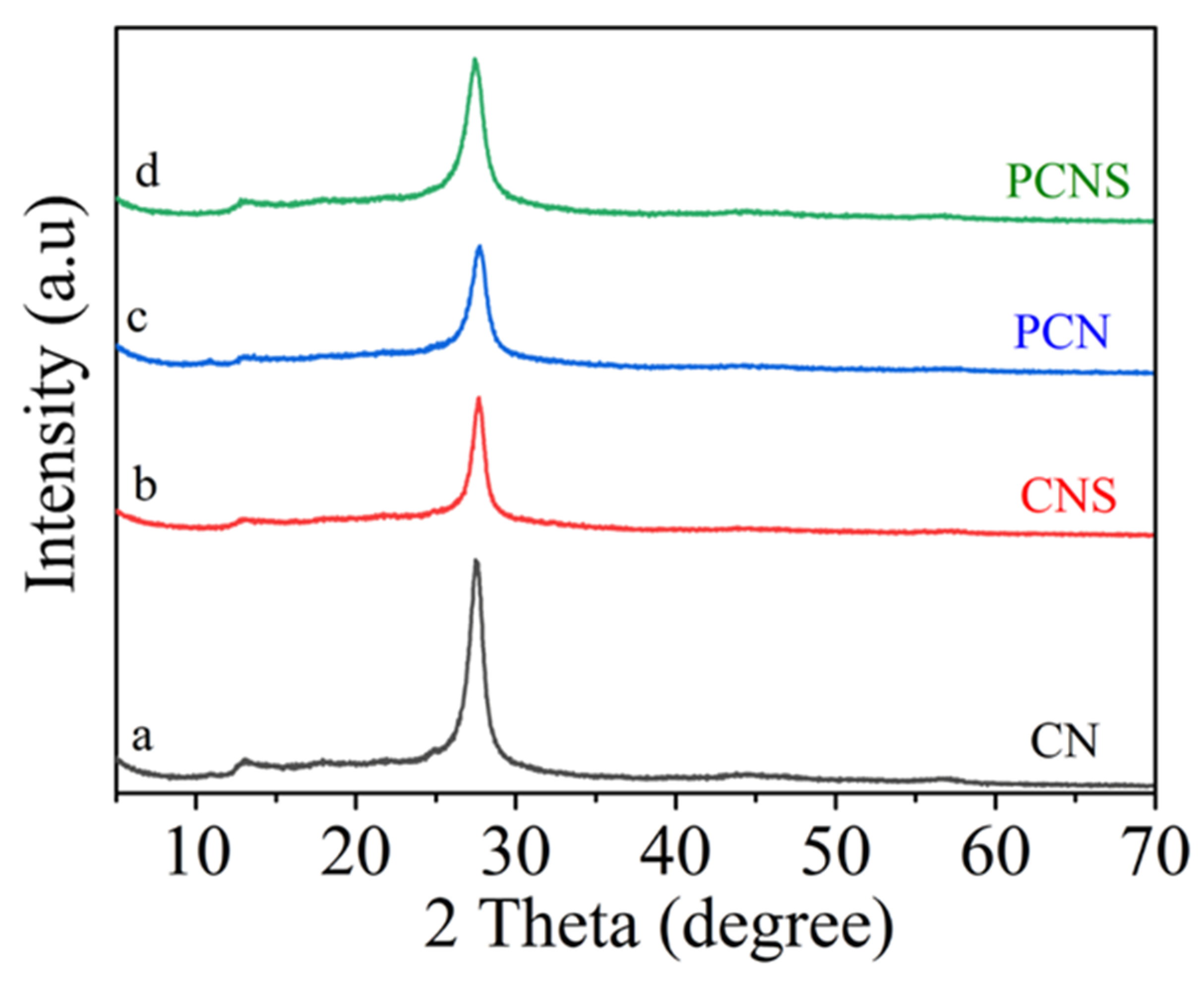
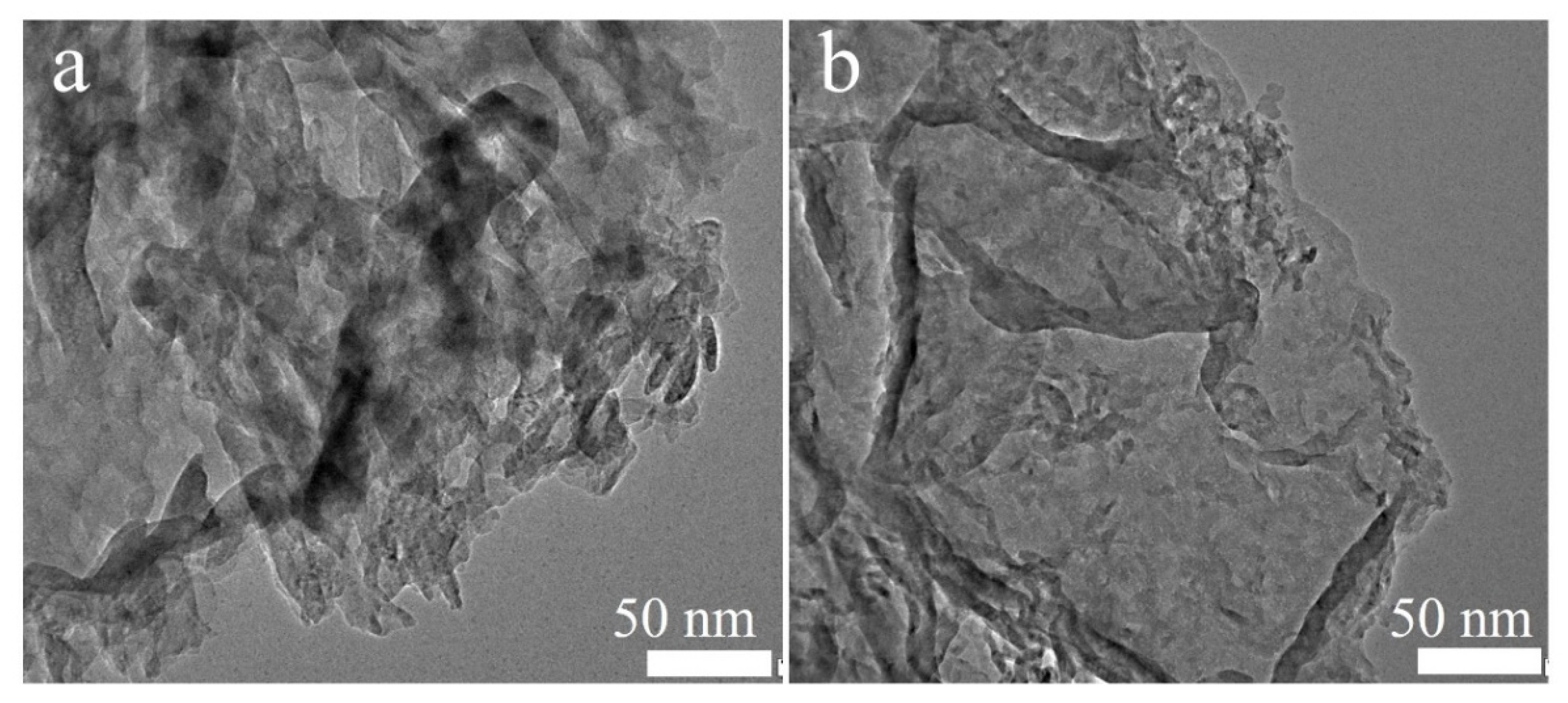
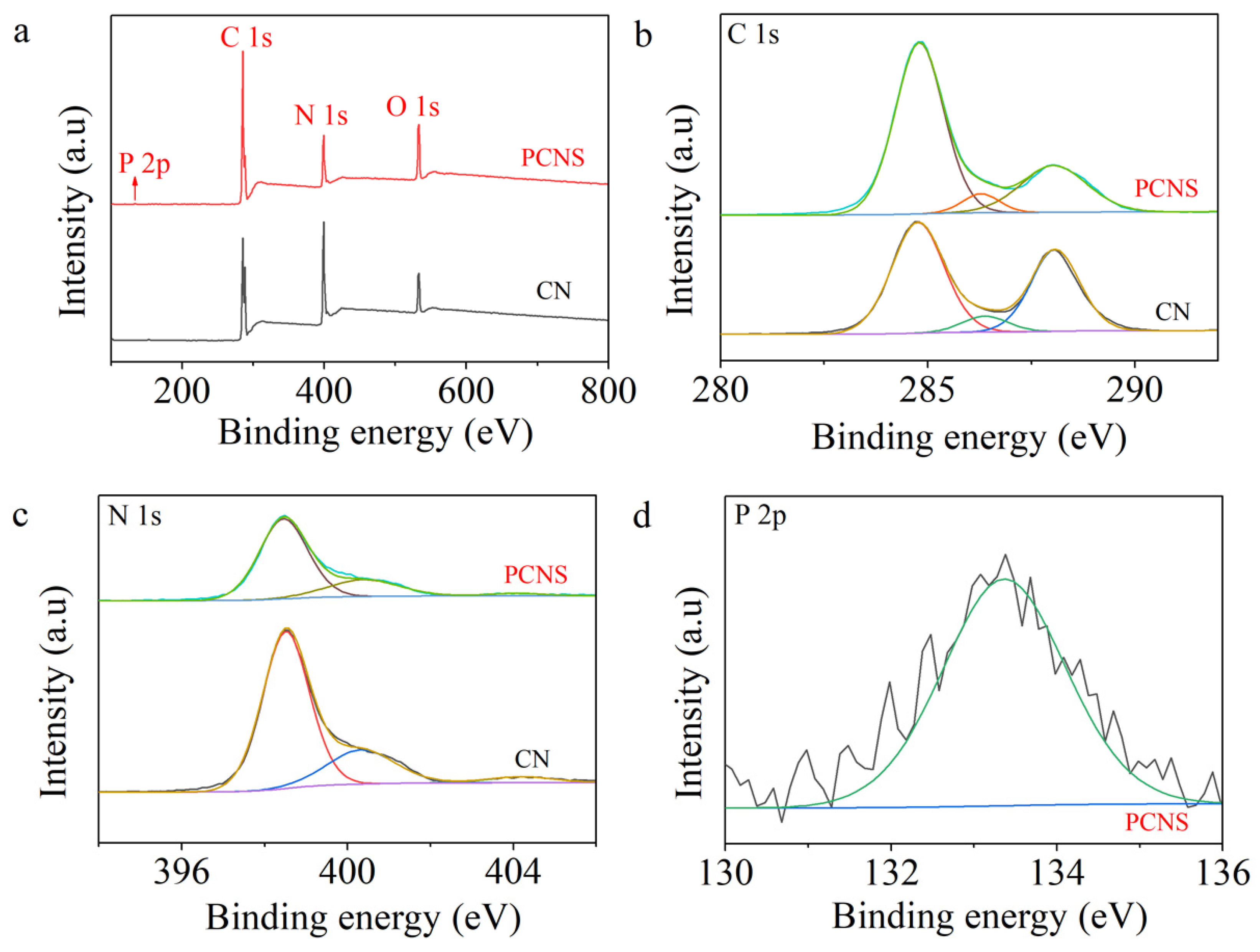
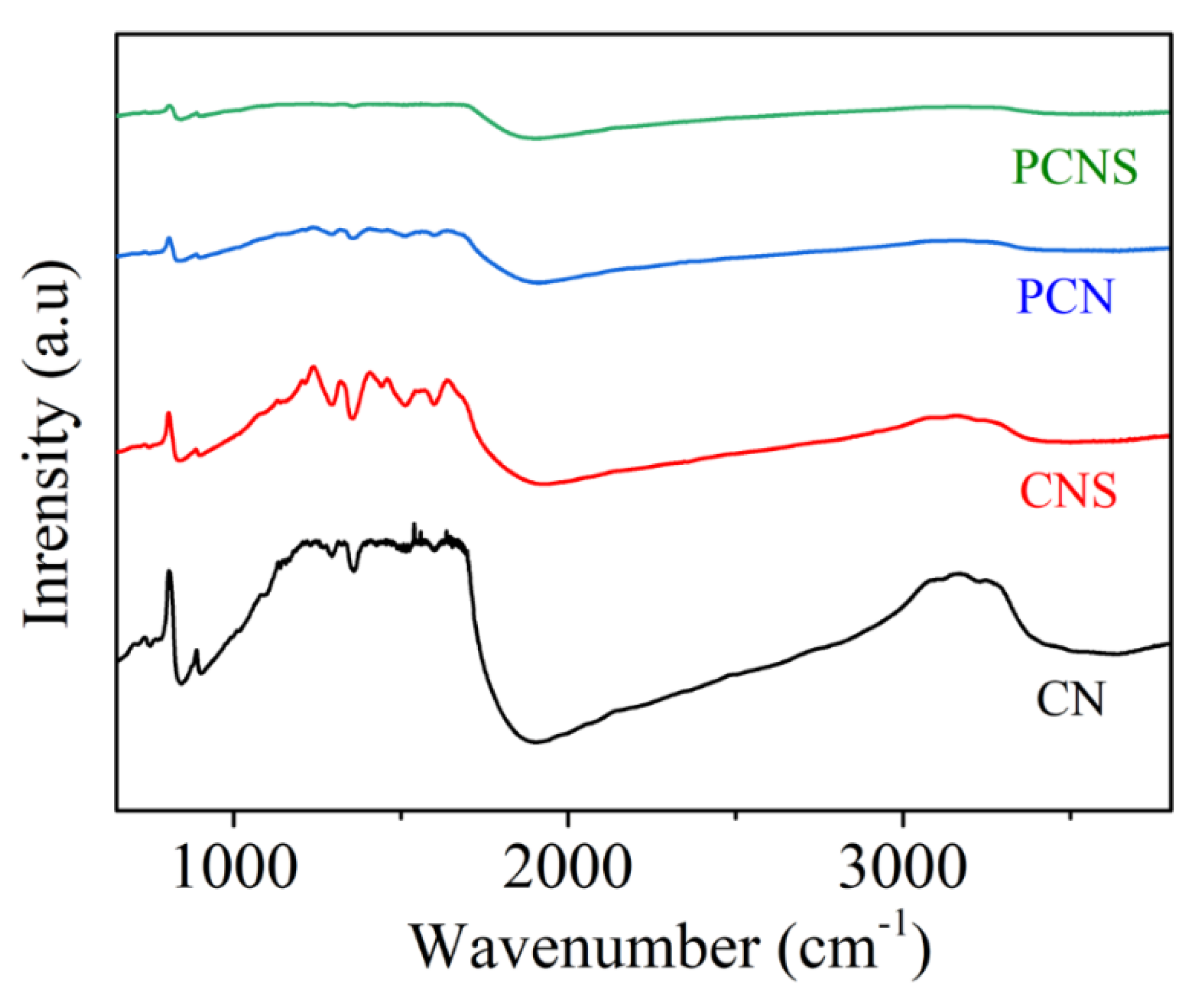

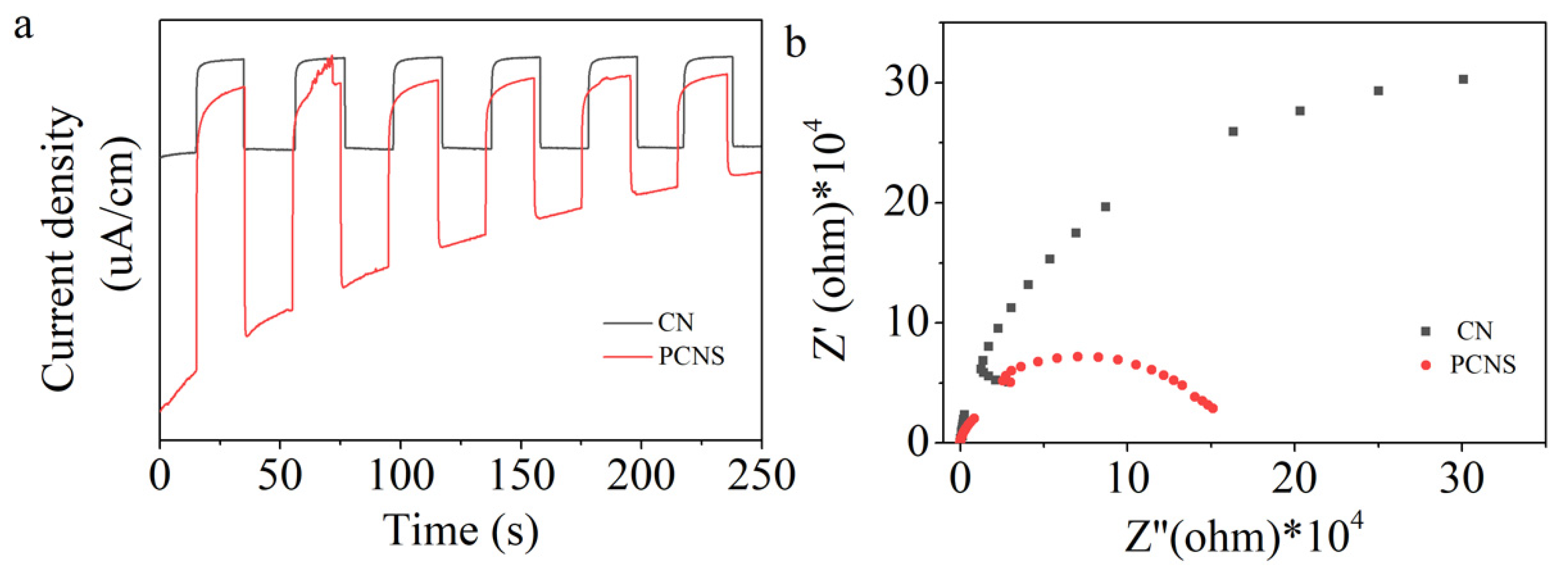

Disclaimer/Publisher’s Note: The statements, opinions and data contained in all publications are solely those of the individual author(s) and contributor(s) and not of MDPI and/or the editor(s). MDPI and/or the editor(s) disclaim responsibility for any injury to people or property resulting from any ideas, methods, instructions or products referred to in the content. |
© 2024 by the authors. Licensee MDPI, Basel, Switzerland. This article is an open access article distributed under the terms and conditions of the Creative Commons Attribution (CC BY) license (https://creativecommons.org/licenses/by/4.0/).
Share and Cite
Chen, L.; Zhang, L.; Xia, Y.; Huang, R.; Liang, R.; Yan, G.; Wang, X. Thermal Exfoliation and Phosphorus Doping in Graphitic Carbon Nitride for Efficient Photocatalytic Hydrogen Production. Molecules 2024, 29, 3666. https://doi.org/10.3390/molecules29153666
Chen L, Zhang L, Xia Y, Huang R, Liang R, Yan G, Wang X. Thermal Exfoliation and Phosphorus Doping in Graphitic Carbon Nitride for Efficient Photocatalytic Hydrogen Production. Molecules. 2024; 29(15):3666. https://doi.org/10.3390/molecules29153666
Chicago/Turabian StyleChen, Lu, Linzhu Zhang, Yuzhou Xia, Renkun Huang, Ruowen Liang, Guiyang Yan, and Xuxu Wang. 2024. "Thermal Exfoliation and Phosphorus Doping in Graphitic Carbon Nitride for Efficient Photocatalytic Hydrogen Production" Molecules 29, no. 15: 3666. https://doi.org/10.3390/molecules29153666
APA StyleChen, L., Zhang, L., Xia, Y., Huang, R., Liang, R., Yan, G., & Wang, X. (2024). Thermal Exfoliation and Phosphorus Doping in Graphitic Carbon Nitride for Efficient Photocatalytic Hydrogen Production. Molecules, 29(15), 3666. https://doi.org/10.3390/molecules29153666







